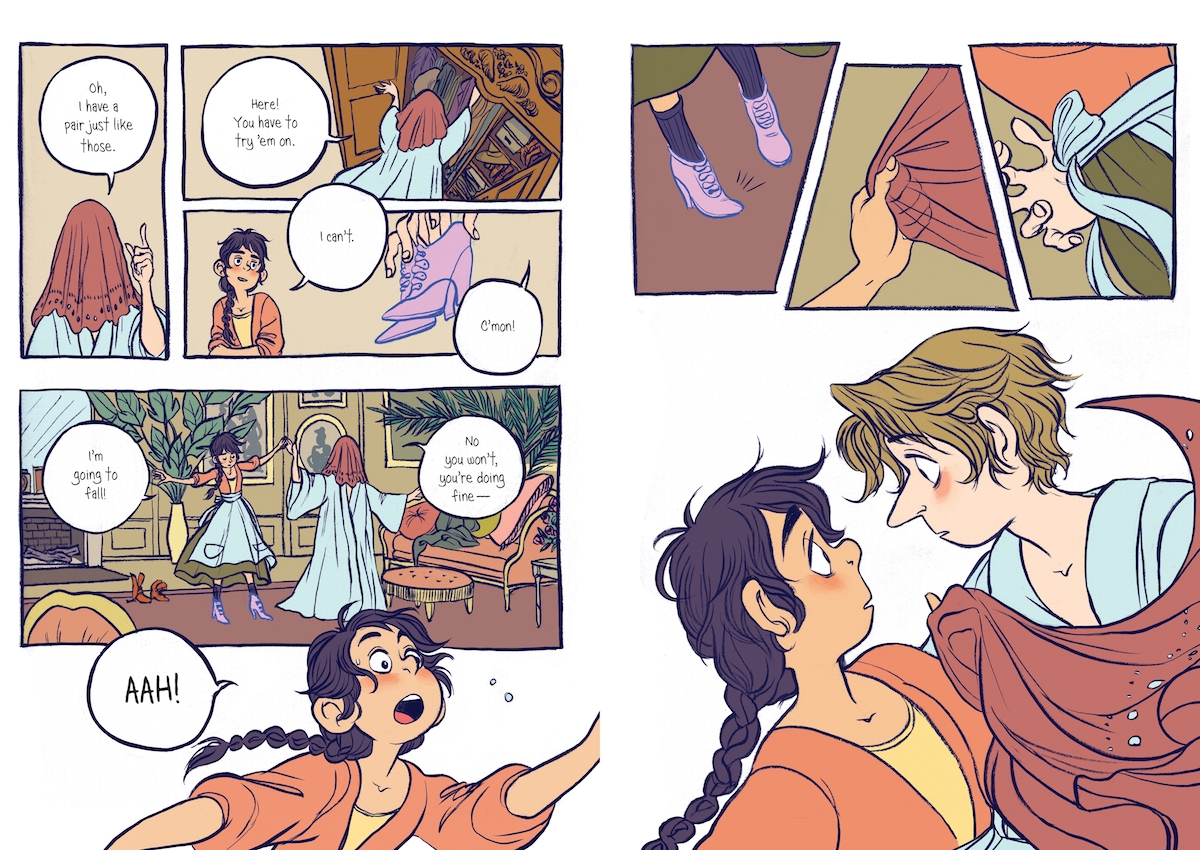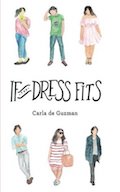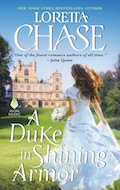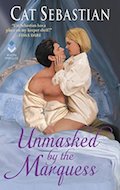Kissing Books: the coded dress
Every month, Olivia Waite pulls back the covers, revealing the very best in new, and classic, romance. We're extending a hand to you. Won't you take it? And if you're still not sated, there's always the archives.
This month I intended to write something frothy about clothing in romance. About the linen and muslin and silk of historicals, the wool suits and high heels of contemporaries, the uniforms of sports romances, the dragon-scarred leathers of fantasy romance, or the nano-regulated synthetic fabrics of the future in SFR (sci-fi romance, for those in the know). But every time I reached into the froth I found a chunk of solid substance underneath that brought me up short.
Consider the dress code.
Fashion, we tell our youth, is a frivolous matter. It marks you as shallow and materialistic (if you’re read as female) and potentially queer (if you’re read as male). It is classed as neither a science nor an art; at best it’s a hobby, harmless but ultimately unimportant.
And we will ban you from school if you do it wrong.
Even the definition of “wrong” depends on so many different factors: geography, audience, time of day, social group, gender, race, religion, body shape, ability. Anyone who has ever overdressed for a party knows how nebulous the rules are, and yet how painful it is when you fail to follow them. Fashion in fiction is even more fraught, because it’s never an accident: it’s chosen (by the author, if not always by the characters), so it can only add meaning. The billionaire’s meticulously tailored suit advertises his power and wealth. The debutante’s pristine gloves are there to be slowly undone, one pearl button at a time.
But this meaning is as slippery as the rules: take, for instance, a red dress. The shy heroine could wear it to show her newly found confidence, which the best friend-turned-lover hero has been helping her build up — or a brash no-nonsense heroine could wear it because she knows she looks awesome and she wants to show the enemy-but-not-for-long hero what he’s missing, the jerk. If the Other Woman is wearing a red dress, it could show she’s sexually aggressive — or it could be because it’s an expensive couture number that flaunts her social status and how faux-perfect she is for our wealthy hero (unlike our poor but authentic heroine). There’s even a famous historical romance where it’s the hero wearing the red dress (Anna Cowan’s Untamed). Clothing motifs, it turns out, are endlessly fluid and adaptable, even when they’re using the same general pattern. I could probably write a fifty-page dissertation just on gloves in historical romance, without ever having to look beyond the books in my personal library. And that’s not even going into the fact that my library is very Western-centric (I’m working on it!) and there’s heaps more possible interpretations when setting romances in non-Western cultural traditions.
Because clothing is never just about fabric, or even just about fabric and bodies. The overall look of a garment depends on the shape and color of the body wearing it, yes — but it also depends on the eye of the beholder, to a degree we don’t always acknowledge openly (unless we’re yelling rebuttals at Project Runway judges because seriously, are we even looking at the same pieces sometimes???). Fashion is a bit like a book, in that sense: one person puts it together, and another person looks at it, and the artistry happens in the space where the building and the looking connect. Fashion is more than just a medium: it’s a language, capable of everything from bawdy limericks to epic tragedies to ephemeral, mutable slang.
This month’s books have a seamstress in Belle Époque Paris, a fat fashionista in modern-day Manila, a runaway Regency bride whose escape ruins more than her gown, a nonbinary Regency heroine who gives up gowns entirely, and a midcentury model for a haute couture house. For some characters, clothing is a business; for others, a vital medium for self-expression and identity. It may be fun (Lady Crystallia’s lavish frocks, Martha’s chic officewear, Robin Selby’s piratical lace cuffs), but it’s never, ever frivolous.
Recent Romances:

The Prince and the Dressmaker by Jen Wang (First Second Books: historical YA nonbinary/f graphic novel):
When my print copy of this lovely book arrived in the mail, it caught Mr. Waite’s eye. He picked it up, flipped to the back, gasped audibly, and slammed the book shut again. “You are going to love this,” he said fervently.
I told this story to a friend who’d given the book five stars. She said: “I know exactly what he was looking at. And yes, you’re going to love it.”
Reader, they were right. I knew the page as soon as I reached it. And heaven help me, but I clapped a hand over my mouth and sobbed aloud in such pure delight that I’m crying a bit right now even thinking about it.
When I reached the end, I went right back to the beginning and read it a second time straight through. It’s that good.
I am now ravenous for other people to read this book. Part of me wants to stand outside on the lawn a la Lloyd Dobbler, but instead of that boombox I’d be holding up a blown-up image of one early moment from page 50 to 51. Partly it’s because this story hits so many of my personal YES PLEASE buttons — seamstress heroine, arranged marriages, historical Paris, fashion as art, queer identity, characters in disguise — but also because it’s just such a beautiful, detailed, and kind piece of work that it feels like a gift Jen Wang has made for all of us. Keeping it to myself feels positively selfish.
Our heroine Frances is a gifted young seamstress working too hard for a thankless boss in Belle Époque Paris. One shocking dress for a prickly client gets her fired — but it also gets her noticed by Prince Sebastian of Brussels. Sebastian’s parents are seeking a princess to betroth him to, but Sebastian would much rather be putting on a red wig and a stunning gown and dazzling Paris as Lady Crystallia, everyone’s favorite fashion trendsetter. The two become partners in couture, best friends, and maybe something more — but political marriages, commercial opportunities, and the constricting nature of secret identities threaten the bond between them.
It may be the happiest happy ending I have read in some time. Plus a rich and sophisticated color palette, dazzling gowns, lovely organic inky brushstrokes, and a bonus feature at the end on the artist’s process that I found absolutely fascinating.


If the Dress Fits by Carla de Guzman (Midnight Books: contemporary m/f):
It’s a good thing I read this book in digital form, because if I’d been reading it in print there’d be drool stains on every page. Romance novels and food often go hand in hand (check out reviewer Elisabeth Lane’s marvelous Cooking Up Romance, for instance) but this book takes it to new heights.
And cheese hopia and tarragon tea aren’t the only things to yearn for in the pages of this Philippines-set romantic comedy. Our hero Max is a tall, shy, bookish veterinarian who’s so achingly in love with our narrator heroine from the beginning that at times I had to put the book down just to catch my breath. I love a good unrequited plotline, and this one is particularly stunning. Heroine Martha, meanwhile, is distracted from recognizing Max’s feelings (and her own, aaaaaa) by her demanding family and her self-consciousness about her size and her helpless crush on the gorgeous Enzo, her former theater friend — who just happens to be newly engaged to her perfect, petite cousin. And of course they want Martha to be the maid of honor! And do all the party planning!
This story really knows how to twist the drama knife without going over the line into excruciating, and if Martha is a little frustrating at times, well, so is Emma Woodhouse. This is also a book with a fat heroine that’s realistic about shame and microaggressions without making her weight into The Entire Issue of her life. Martha doesn’t have to learn to love herself — but she does have to learn to tell people that she loves her shape, and to imagine that other people might love it too. It’s the kind of book where everyone is perfectly imperfect, which I found delightful even though I wanted to shake every character at least once when they were being stubborn or scared or short-sighted.
Don’t read when hungry. You have been warned.
”Because I loved you,” I said to him. The words spilled out of my mouth before I could stop them, like the beads on a necklace that had snapped. They scattered everywhere, and it was impossible to catch them all now.

A Duke in Shining Armor by Loretta Chase (Avon: historical m/f):
The beginning of this book is a masterpiece in how to start at the latest possible point in a story and let the characters’ actions reveal who they are.
We begin at the wedding. The groom, the Duke of Ashmont, is drunk and growing belligerent. The bride, Lady Olympia Hightower, also drunk, was supposed to walk down the aisle half an hour ago. The groom sends his best friend, the Duke of Ripley, to investigate — he sees the bride slipping out the back window, and hies off in pursuit. But Ripley never did like to follow the rules, so before long instead of dragging the desperate woman back to the altar he’s aiding and abetting her escape. As the chase extends, that first question — just what is our bride running from? — becomes much less important than the second one: just what does our bride really want?
Like de Guzman’s book it’s all very High Comedy, a Regency It Happened One Night. There are falls into mud puddles, a rescued pup, accidentally seeing each other in the bath, sudden thunderstorms soaking people to the skin, and so on. This lightness masks a surprisingly powerful center, though: Ripley’s fall into love in particular is beautifully done, and the sex scenes verge on poetry (good poetry, I should clarify). Oh, and Ripley is a romance reader: he loves a good pulpy story full of feelings, whereas bespectacled, antiquarian Olympia devises her own library organization systems and cares more for original Gutenberg incunabulae than for novels. After a long stretch where I felt Chase’s books were phoning it in, this book shows up with all the chime and energy of a live brass band.
He was a man, and not a virtuous one.
And so, when he should have said, No, wait, and then added something sensible and correct...he didn’t.
Instead, he walked straight into trouble, the way he always did. He walked the few steps to Doing the Wrong Thing. Then she was in his arms, soft and willing and learning far too quickly how to make him delirious.
And now.
Yes, she said.
Yes, of course. What other choice was there?

Unmasked by the Marquess by Cat Sebastian (Avon Books: historical m/nonbinary):
Three months ago I talked about cross-dressing heroines and Suzanne Enoch’s Lady Rogue. Kit Brantley had been raised as a boy but ends up living as a woman: in Cat Sebastian’s newest, heroine Robin Selby had adopted her late lover’s identity for practical reasons (to protect the man’s sister, who’d been left destitute by the will) but finds that dressing in breeches and waistcoats feels right in a way that gowns and chemises never have. What follows is a long exploration of the difference between what it means to do what’s proper and what it means to do what’s right. It’s a resounding step towards inclusivity for a much-loved but often-dicey romance trope.
Let’s follow Robin’s example and be practical to start: I’ve seen the heroine’s gender described elsewhere as nonbinary, and doing that in a Regency setting definitely presents some challenges. For instance: pronouns. Robin uses she/her for her internal monologue but definitely identifies with gentlemanly things when it comes to manners and mode of dress. One content note: hero Alistair does more than once refer to Robin as a ‘deceiver’ for wearing waistcoats, and pitches a truly epic fit when he first learns of the name-swap. He does not, importantly, have to ‘get over’ the essential fact of Robin’s gender; he’s into both men and women and reasonably comfortable with that. But it was a scene I worried might hit some people more sharply than others, so I wanted to note it here.
Now the subjective stuff: this book is a pleasure that cuts deep. It’s a slow-motion stained-glass heartbreak, all sparkling color and velvet shadow and sharp edges slicing you without mercy. Cat Sebastian definitely draws her couples as strong contrasts, and here Robin is sunshine and springtime, while Alistair is all brooding stodginess and stern propriety. Up to a point, of course. Robin’s charm masks a yawning fear that she has no real identity — no family, no status, and most painfully no name — and this makes her prone to extreme self-sacrifice. It’s easy to give up everything when you feel like none of it really belongs to you. And Alistair’s tendency to go full supervillain to protect his loved ones clearly brings him more devious pleasure than it should: he flings money at problems, wields his privileges like weapons, and at one point actually threatens an antagonist while sitting in a library chair and stroking a cat. He’s been working all his life to be the opposite of his spendthrift, drink-sodden, orgy-loving, bastard-fathering father. Watching him learn to let his human heart show is satisfying; watching Robin learn to really feel as carefree as she pretends is painfully sweet. I devoured the whole thing in a single afternoon and was then good and useless for the next three days. If you need something to give you a book hangover like you’re Bertie Wooster after a bender, this is the book for you.
Alistair walked directly to the stables and was in his traveling chaise within a quarter of an hour. By the time he realized he was still holding the kitten it was too late to turn back.
This Month’s Vintage Harlequin Heroine

Under the Stars of Paris by Mary Burchell (Harlequin Romance: contemporary m/f):
A good category romance has all the effortless, exquisite clarity of a fine diamond: everything that doesn’t sparkle is ruthlessly polished away until only the light is left. This is the oldest romance I have reviewed so far, but even though it was first published in 1954 it fizzes like the cork was just popped. Heroine Anthea is freshly heartbroken and semi-destitute in mid-century Paris; she stumbles into a hair salon to avoid an awkward encounter and lands herself a job as a mannequin (read: model) for the best couture house in France. She steps onto the runway in a dazzling wedding gown — only to see her caddish ex-fiancé there in the front row, with his new bride-to-be! The stakes are personal but they feel infinitely meaningful; this is the kind of book where a spill of Merlot is as good as a murder. Like most categories of the old school, it’s told entirely from the heroine’s point of view, so that we are not even certain of who the real hero is until very nearly the end of the book. (We can be reasonably sure it’s not the caddish ex-fiancé.) It’s all a delightful confection, full of lustrous fabrics, seething jealousies, and shimmering tears.
Also, this book helped fight Nazis.
Okay technically not this book — but its author Ida Cook (writing as Mary Burchell) used the funds from her romance career in the 1930s to fund trips to Germany for herself and her sister. They went ostensibly to see some of the great opera performances of the age. In reality, they were smuggling valuables out of the country to help Jewish refugees, in direct defiance of Nazi law. Britain only allowed immigration for those who had either employment or sufficient funds to support themselves, but Jewish emigrants weren’t permitted to take possessions or funds out of Germany. It was a terrible bind. The Cook sisters would arrive at the border in plain clothing, and leave bedecked in jewels and furs, which they’d return to the owners once reunited in Britain. If any border guards asked why they were so kitted out, they played the eccentric spinsters and said they had untrustworthy relatives at home, so they always traveled with all their jewelry. This worked at least a dozen times, and after the war the sisters were named Righteous Gentiles.
“You are what you do,” Ida is quoted as saying. We should all have such clarity of purpose.